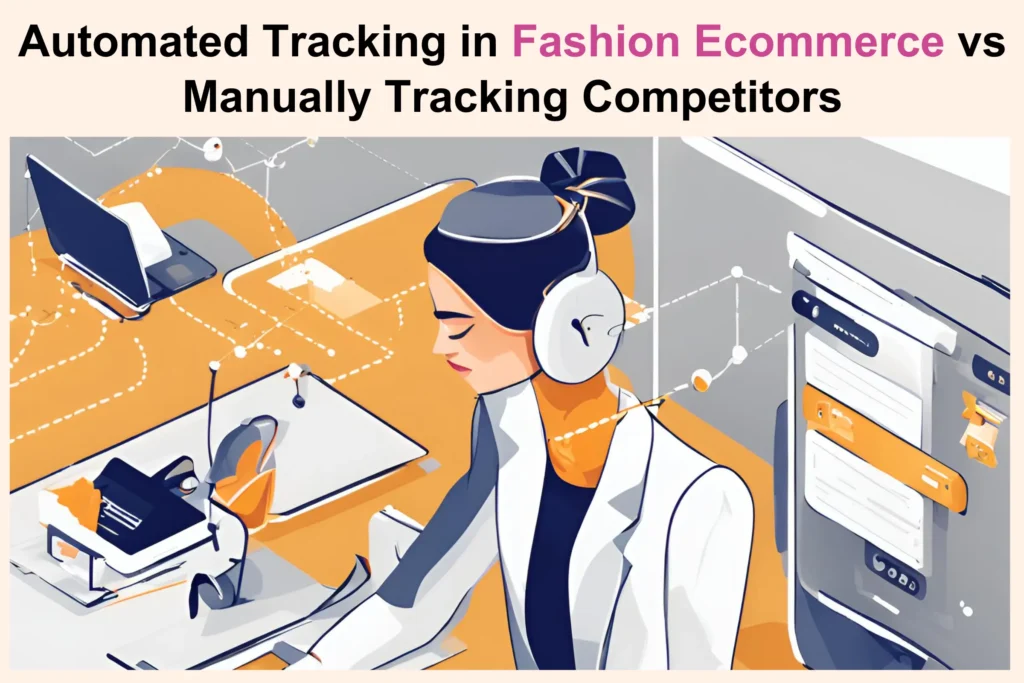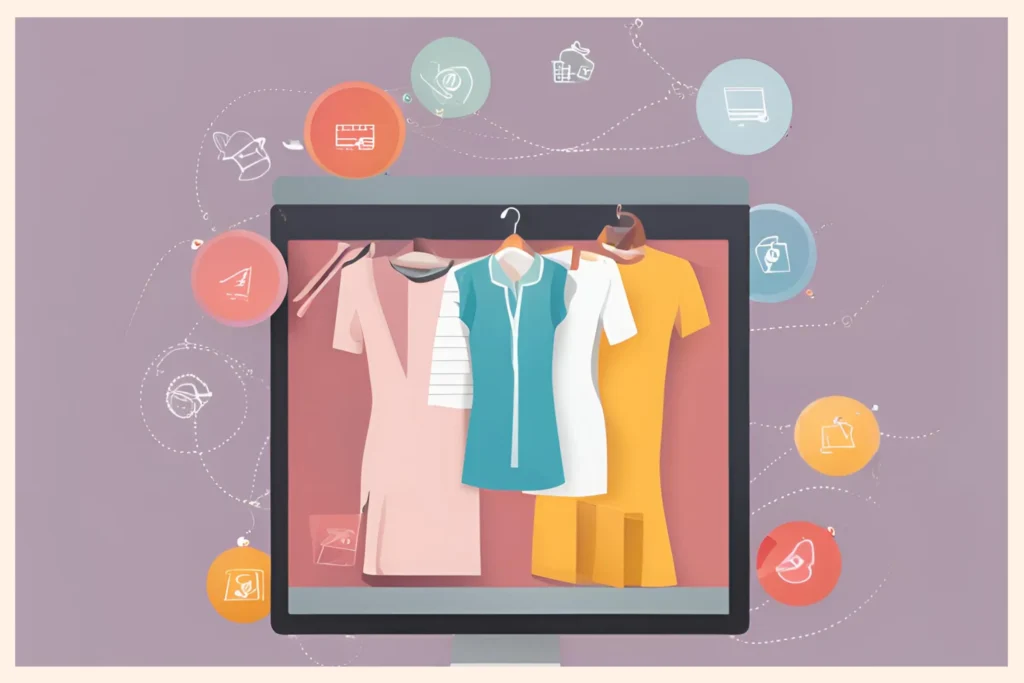In the dynamic world of fashion e-commerce, keeping your finger on the pulse of your competitors is crucial for success.
Understanding their pricing strategies, product offerings, marketing tactics, and brand identity allows you to make informed decisions and stay ahead of the curve.
But when it comes to competitor tracking, two main approaches emerge: manual tracking and automated tracking.

In this blog, we will equip you with the knowledge to choose the best approach for your specific needs, ensuring you stay competitive as you navigate the ever-evolving fashion landscape.
The Importance of Competitor Tracking in Fashion E-commerce
The fashion e-commerce market is a booming one, projected to reach a staggering value of over $200 billion by 2025. With such intense competition, staying informed about your rivals’ strategies becomes paramount.
Competitor tracking is essential for:
- Price Optimization: Analyze competitor pricing to ensure your offerings are competitively priced without sacrificing profitability.
- Product Development: Gain insights into trending products, styles, and materials your competitors are offering to inform your own product development strategy.
- Marketing Insights: Learn from your competitors’ marketing campaigns (social media strategies, influencer collaborations, etc.) to craft effective and targeted campaigns for your own brand.
- Identify Opportunities: Uncover gaps in the market that your competitors might be missing, allowing you to carve out a unique niche.
A Fashionable Example:
Imagine you own a fashion e-commerce store specializing in sustainable, ethically sourced denim. By tracking competitors, you might discover a gap in the market for plus-size options in sustainable denim. This valuable insight allows you to develop a targeted product line and marketing campaign to capture this underserved segment.
Now, let’s dive deeper into the two main approaches to competitor tracking:
Method 1: Manual Competitor Tracking – The DIY Approach
Manual tracking relies on your own efforts and readily available online tools. Here’s what it entails:
- Competitor Selection: Identify your key competitors both in terms of market share and brand positioning.
- Website Monitoring: Regularly visit competitor websites to track changes in pricing, product offerings, promotions, and marketing campaigns.
- Social Media Monitoring: Follow your competitors on social media to analyze their content strategy, engagement levels, and influencer collaborations.
- Price Tracking Spreadsheets: Create spreadsheets to manually track competitor pricing for different product categories.
- Industry Research: Read industry publications, attend fashion e-commerce conferences, and participate in online forums to gain insights into broader industry trends and competitor strategies.

Benefits of Manual Tracking:
- Cost-Effective: This method requires no additional software subscriptions, making it budget-friendly for smaller businesses.
- Granular Control: You have full control over the data you collect and how you analyze it.
- Deeper Understanding: Manually monitoring competitor websites and social media can provide a deeper understanding of their brand identity and communication style.
Challenges of Manual Tracking:
- Time-Consuming: Manually collecting data is a tedious and time-consuming process, especially as your business grows and the number of competitor offerings expands.
- Inaccuracy: There’s a high risk of human error when manually inputting and analyzing data.
- Limited Scope: It’s difficult to track real-time price fluctuations or monitor a large number of competitors efficiently with the manual approach.
P.S. When you don’t use any software tools, you may save money, but you use valuable time in which you could have made more money doing something else to grow your business.
Ideal Scenario for Manual Tracking:
This approach might be suitable for smaller fashion e-commerce businesses with limited resources and a relatively small number of competitors to track. Additionally, for businesses that have too much time.
“The best way to find your own voice is to listen to everyone else’s.”
– Diana Vreeland, American fashion columnist and editor
While manual tracking offers some benefits, its limitations become apparent for businesses that need more efficient and comprehensive competitor insights.
Method 2: Automated Competitor Tracking – The Tech-Powered Solution
Automated competitor tracking utilizes specialized software solutions, like www.plumfind.com, to gather and analyze competitor data. These tools can track various aspects of your competitors’ online presence, including:
- Pricing: Track competitor pricing in real-time, receive alerts for price changes, and identify pricing trends.
- Product Assortment: Monitor new product launches, product updates, and discontinued items from competitors.
- Real-Time Insights: Get real-time updates on competitor pricing changes and marketing campaigns.
- Granular Reporting: Receive detailed reports that allow for in-depth competitor analysis and trend identification.
Benefits of Automated Tracking:
- Efficiency: Saves time and resources by automating data collection and analysis.
- Accuracy: Reduces the risk of human error and ensures consistent data quality.
- Scalability: Effectively scales to track a large number of competitors and a wide range of data points.
- Regular Alerts
Examples of Automated Competitor Tracking Tools:
Plumfind: Get actionable insights on your competitors’ prices, promotions, new products and stock levels.
- New Arrivals: Make sure you stay one step ahead of your competitors with real-time insights on new product launches.
- Out of Stock Products: Never miss a beat with insights into your competitors’ out-of-stock variants.
- Product Price Changes: Receive instant notifications when your competitors change their prices, allowing you to adapt your strategies accordingly.
Challenges of Automated Tracking:
- Cost: But you can use www.plumfind.com for FREE
- Data Overload: Automated tools can generate a vast amount of data that requires proper filtering and analysis to extract valuable insights. That’s why Plumfind has developed proper actionable insights.
Ideal Scenario for Automated Tracking:
Automated competitor tracking is a valuable resource for businesses of all sizes, especially those with a large number of competitors or complex pricing strategies. Additionally, fashion e-commerce businesses with limited time or resources to dedicate to manual tracking will find these tools highly beneficial.
Combining Manual & Automated Tracking: A Winning Strategy
While both methods have their pros and cons, the ideal approach often lies in combining both manual and automated tracking.
You can utilize automated tools for collecting and analyzing vast amounts of data to gain a broad overview of competitor activity.
However, manual tracking can still be valuable for gaining a deeper understanding of a competitor’s brand voice, analyzing specific marketing campaigns, or identifying areas where automated data may be inaccurate.
Focus on the “why” before the “how.” Clearly establish your competitor tracking goals before deciding on a method. Then, choose the approach that best helps you achieve those goals within your budget and resource constraints.

Beyond Tracking: Utilizing Competitor Insights for Growth
Once you’ve gathered competitor data, the true power lies in leveraging it for strategic decision-making. Here are some ways to make the most of your competitor insights:
- Inform Your Pricing Strategy: Analyze competitor pricing data to identify price gaps and opportunities for competitive pricing.
- Develop a Winning Product Assortment: Use competitor data to inform your product development strategy, ensuring you offer unique and desirable products.
- Craft Effective Marketing Campaigns: Learn from competitor marketing tactics and adapt successful strategies to your brand voice and target audience.
- Identify Industry Trends: Utilize competitor data to identify broader fashion industry trends and adapt your offerings accordingly.
By effectively tracking and analyzing your competitors, you gain valuable insights that empower you to make informed decisions, differentiate your brand, and achieve sustainable growth in the competitive world of fashion e-commerce.
In conclusion, staying ahead of the curve in fashion e-commerce requires a strategic approach to competitor tracking. Whether you choose manual or automated methods, or a combination of both, remember that the key lies in utilizing data to gain actionable insights. By understanding your competitors’ strategies, you can refine your own approach, strengthen your brand identity, and ultimately achieve success in the dynamic fashion landscape.
About the author(s):
Natasha is our Social Media Manager, a law student, and marketing enthusiast. She loves strategizing different methods to get results. A big fan of startups and their psychological aspects. She loves to travel and interact with locals to know the history of those places. She lives in Jaipur, India.